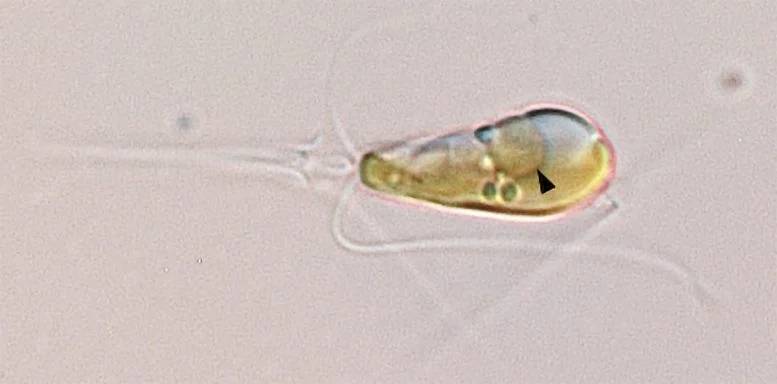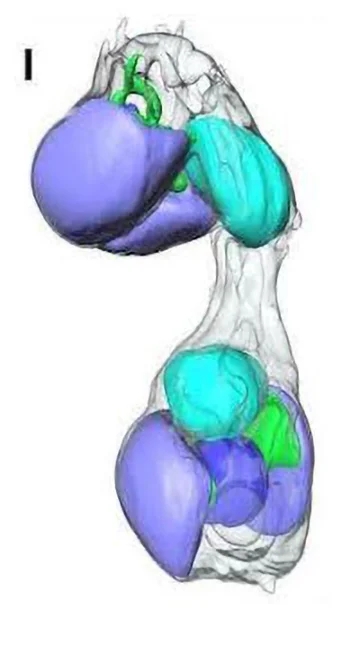博文
长达数十年的谜团——“硝质体”发现挑战现代教科书
 精选
精选
||
长达数十年的谜团——“硝质体”发现挑战现代教科书
诸平
https://scitechdaily.com/a-decades-long-mystery-discovery-of-nitroplast-challenges-modern-textbooks/
据美国加州大学圣克鲁斯分校(University of California - Santa Cruz简称UC Santa Cruz)2024年4月27日提供的消息,长达数十年的谜团——“硝质体”发现挑战现代教科书(A Decades-Long Mystery – Discovery of “Nitroplast” Challenges Modern Textbooks)。
现代生物学教科书断言,只有细菌才能从大气中吸收氮,并将其转化为生命可用的形式。固氮的植物,如豆科植物,是通过在根瘤中藏匿共生细菌来实现的。但最近的一项发现颠覆了这一规律。
在最近的两篇论文中,一个国际科学家小组描述了真核细胞(eukaryotic cell)内已知的第一个固氮细胞器(nitrogen-fixing organelle)。细胞器是原生内共生(primary endosymbiosis)史上的第4个例子,原生内共生是指原核细胞(prokaryotic cell)被真核细胞(eukaryotic cell)吞噬并从共生进化为细胞器的过程。两篇论文详见:Francisco M. Cornejo-Castillo, Keisuke Inomura, Jonathan P. Zehr, Michael J. Follows. Metabolic trade-offs constrain the cell size ratio in a nitrogen-fixing symbiosis. Cell, 2024, 187: 1762-1768.e9. DOI: 10.1016/j.cell.2024.02.016. Published: 11 March 2024. https://www.cell.com/cell/fulltext/S0092-8674(24)00182-X
Tyler H. Coale, Valentina Loconte, Kendra A. Turk-Kubo, Bieke Vanslembrouck, Wing Kwan Esther Mak, Shunyan Cheung, Axel Ekman, Jian-Hua Chen, Kyoko Hagino, Yoshihito Takano, Tomohiro Nishimura, Masao Adachi, Mark Le Gros, Carolyn Larabell, Jonathan P. Zehr. Nitrogen-fixing organelle in a marine alga. Science, 2024, 384(6692): 217-222. DOI: 10.1126/science.adk1075. Published: 11 April 2024.
美国加州大学圣克鲁斯分校(UC Santa Cruz)的博士后学者、2024年4月11日在《科学》(Science)杂志网站发表的论文的第一作者泰勒·科尔(Tyler H. Coale)说:“细胞器从这类物质中产生是非常罕见的。我们第一次认为它发生的时候,它产生了所有复杂的生命。”他说,“任何比细菌细胞更复杂的东西的存在都要归功于这一事件,”他指的是线粒体(mitochondria)的起源。“大约10亿年前,叶绿体(chloroplast)又发生了同样的事情,于是我们有了植物,”泰勒·科尔说。
第3个已知的例子涉及一种类似叶绿体的微生物。最新的发现是固氮细胞器(nitrogen-fixing organelle)的第一个例子,研究人员称之为硝质体(nitroplast)。
长达数十年之谜(A decades-long mystery)
细胞器的发现需要一点运气和几十年的努力。1998年,加州大学圣克鲁兹分校(UC Santa Cruz)海洋科学杰出教授乔纳森·泽尔(Jonathan Zehr),在太平洋海水(Pacific Ocean seawater)中发现了一段似乎来自一种未知的固氮蓝藻(nitrogen-fixing cyanobacterium)的短DNA序列。乔纳森·泽尔和同事们花了数年时间研究这种神秘的生物,他们将其命名为UCYN-A。
与此同时,日本高知大学(Kochi University in Japan)的古生物学家萩野恭子(Kyoko Hagino)正在努力培养一种海藻。它原来是UCYN-A的宿主生物。萩野恭子花了超过300次采样考察和十多年的时间,最终成功地培养出了这种藻类,使其他研究人员可以开始在实验室里一起研究UCYN-A和它的海洋藻类宿主。
多年来,科学家们一直认为UCYN-A是一种与藻类密切相关的内共生体(endosymbiont)。但最近的上述两篇论文表明,UCYN-A在过去的共生关系中与宿主共同进化,现在符合细胞器的标准。
细胞器的起源(Organelle origins)
在2024年3月11日发表在《细胞》(Cell)杂志上的这篇论文中,乔纳森·泽尔和来自美国麻省理工学院(Massachusetts Institute of Technology)、西班牙巴塞罗那城市研究所(Institut de Ciències del Mar in Barcelona)和美国罗德岛大学(University of Rhode Island)的同事们合作研究表明,在不同种类的海洋附生藻Braarudosphaera bigelowii中,UCYN-A和它们的藻类宿主之间的大小比例是相似的。
研究人员发现,UCYN-A及其宿主之间的大小比例在不同亚系/物种之间惊人地保持一致,这与该共生体及其他物种中细胞器的大小关系一致。代谢模型显示,这种大小关系使基于资源获取和交换之间权衡的协调增长率最大化。这些研究结果表明,单细胞真核生物中固定N2的内共生体和细胞器的大小关系受到可预测的新陈代谢基础的制约,UCYN-A在许多方面的功能类似于潜在的N2固定细胞器或硝质体(nitroplast)。
研究人员使用一个模型来证明宿主细胞和UCYN-A的生长是由营养物质交换控制的。他们的新陈代谢是有联系的。这种生长速率的同步使研究人员将UCYN-A称为“类细胞器”(“organelle-like”)。
乔纳森·泽尔说:“这正是细胞器所发生的事情。如果你观察一下线粒体和叶绿体,就会发现它们是一样的:它们与细胞成比例。”
但在确认其他证据之前,科学家们并没有自信地将UCYN-A称为细胞器。在《科学》(Science)杂志的封面文章中,来自美国加州大学圣克鲁兹分校(UC Santa Cruz)、美国加州大学旧金山分校(University of California, San Francisco简称UCSF)、美国劳伦斯伯克利国家实验室(Lawrence Berkeley National Laboratory)、中国台湾海洋大学(Taiwan Ocean University, China)、日本高知大学(Kochi University in Japan)的合作者的研究表明,UCYN-A从宿主细胞中进口蛋白质。
乔纳森·泽尔说:“这是某种生物从内共生体转变为细胞器的标志之一。它们开始丢弃DNA片段,它们的基因组变得越来越小,它们开始依赖母细胞来获得这些基因产物或蛋白质本身来运输到细胞中。”
泰勒·科尔负责这项研究的蛋白质组学。他比较了在分离的UCYN-A中发现的蛋白质与在整个藻类宿主细胞中发现的蛋白质。他发现宿主细胞制造蛋白质,并用特定的氨基酸序列标记它们,这告诉细胞将它们送到硝质体。然后硝质体输入蛋白质并使用它们。泰勒·科尔发现了其中一些蛋白质的功能,它们填补了UCYN-A中某些通路的空白。
乔纳森·泽尔说:“这就像一个神奇的拼图游戏,实际上可以组合在一起并起作用。”
在同一篇论文中,来自加州大学旧金山分校(UCSF)的研究人员表明,UCYN-A与藻类细胞同步复制,并像其他细胞器一样遗传。
改变观点(Changing perspectives)
这些独立的证据表明,UCYN-A已经超越了共生体(symbiont)的作用。线粒体和叶绿体是在数十亿年前进化的,而硝质体(nitroplast)似乎是在大约1亿年前进化的,这为科学家们提供了一个新的、更近的关于器官发生(organellogenesis)的视角。
细胞器还提供了对海洋生态系统的洞察。所有生物都需要生物可用形式的氮,而UCYN-A因其从大气中固定氮的能力而具有全球重要性。研究人员发现,从热带到北冰洋(Arctic Ocean),它无处不在,它能固定大量的氮。
乔纳森·泽尔说:“它不仅仅是另一个玩家。”
这一发现也有可能改变农业。从大气中的氮合成氨肥料的能力使农业和世界人口在20世纪初开始腾飞。被称为哈伯-博世合成法(Haber-Bosch process),它使世界上大约50%的粮食生产成为可能。它还产生了大量的二氧化碳:大约1.4%的全球排放量来自这个过程。几十年来,研究人员一直试图找到一种将自然固氮结合到农业中的方法。
泰勒·科尔说,“这个系统是研究固氮的一个新视角,它可能为如何将这种细胞器改造成农作物提供线索。”
但关于UCYN-A及其藻类宿主的许多问题仍未得到解答。研究人员计划更深入地研究UCYN-A和藻类的运作方式,并研究不同的菌株。
加州大学圣克鲁斯分校的助理教授肯德拉·特尔克-库博(Kendra Turk-Kubo)将在她的新实验室继续这项研究。乔纳森·泽尔希望科学家们能找到其他与UCYN-A有着相似进化故事的生物,但这是第一次,这一发现也是教科书发现。
上述介绍,仅供参考。欲了解更多信息,敬请注意浏览原文或者相关报道。
Abstract (DOI: 10.1016/j.cell.2024.02.016)
Biological dinitrogen (N2) fixation is a key metabolic process exclusively performed by prokaryotes, some of which are symbiotic with eukaryotes. Species of the marine haptophyte algae Braarudosphaera bigelowii harbor the N2-fixing endosymbiotic cyanobacteria UCYN-A, which might be evolving organelle-like characteristics. We found that the size ratio between UCYN-A and their hosts is strikingly conserved across sublineages/species, which is consistent with the size relationships of organelles in this symbiosis and other species. Metabolic modeling showed that this size relationship maximizes the coordinated growth rate based on trade-offs between resource acquisition and exchange. Our findings show that the size relationships of N2-fixing endosymbionts and organelles in unicellular eukaryotes are constrained by predictable metabolic underpinnings and that UCYN-A is, in many regards, functioning like a hypothetical N2-fixing organelle (or nitroplast).
Editor’s summary (DOI: 10.1126/science.adk1075)
Many partnerships have been formed between nitrogen-fixing microbes and carbon-fixing eukaryotes that need nitrogen to grow. The possibility of a eukaryote with a nitrogen-fixing organelle derived from endosymbiosis, which is called a nitroplast, has been speculated. Studying a marine alga with a cyanobacterial endosymbiont, Coale et al. used soft x-ray tomography to visualize cell morphology and division of the alga, revealing a coordinated cell cycle in which the endosymbiont divides and is split evenly, similar to the situation for plastids and mitochondria in these cells (see the Perspective by Massana). Proteomics revealed that a sizable fraction of the proteins in this structure are encoded by and imported from the alga, including many that are essential for biosynthesis, cell growth, and division. These results offer a fascinating view into the transition from an endosymbiont into a bona fide organelle. —Michael A. Funk
Abstract (DOI: 10.1126/science.adk1075)
Symbiotic interactions were key to the evolution of chloroplast and mitochondria organelles, which mediate carbon and energy metabolism in eukaryotes. Biological nitrogen fixation, the reduction of abundant atmospheric nitrogen gas (N2) to biologically available ammonia, is a key metabolic process performed exclusively by prokaryotes. Candidatus Atelocyanobacterium thalassa, or UCYN-A, is a metabolically streamlined N2-fixing cyanobacterium previously reported to be an endosymbiont of a marine unicellular alga. Here we show that UCYN-A has been tightly integrated into algal cell architecture and organellar division and that it imports proteins encoded by the algal genome. These are characteristics of organelles and show that UCYN-A has evolved beyond endosymbiosis and functions as an early evolutionary stage N2-fixing organelle, or “nitroplast.”
https://blog.sciencenet.cn/blog-212210-1432170.html
上一篇:科学家们困惑了50多年,一个圣杯般的化学之谜终于解开了
下一篇:三分之一的心血管疾病死亡是由于饮食不良


